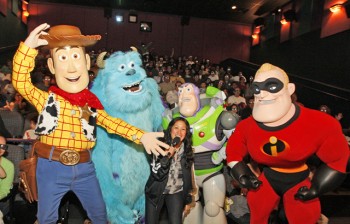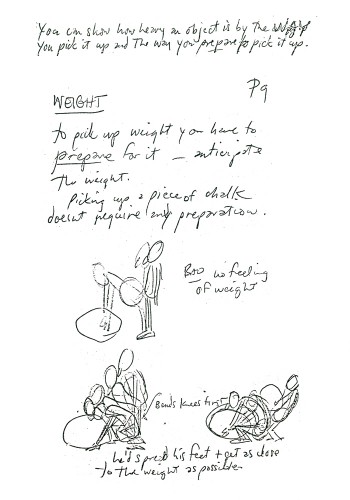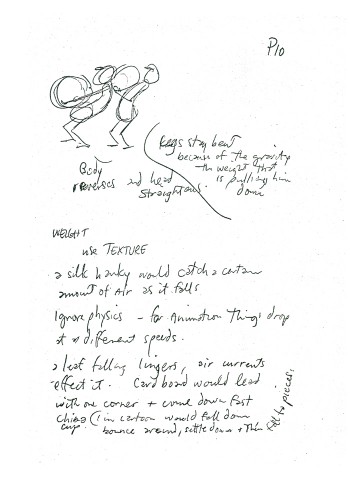Commentary 14 May 2011 06:58 am
Left overs
 - Anthony Lane has written an expressive and interesting piece for The New Yorker Magazine. I felt the article about Pixar intelligent and well-worth reading. Perhaps the fact that I haven’t visited the Emeryville factory, made the piece informative and amusing to me. This is something written for the general public.
- Anthony Lane has written an expressive and interesting piece for The New Yorker Magazine. I felt the article about Pixar intelligent and well-worth reading. Perhaps the fact that I haven’t visited the Emeryville factory, made the piece informative and amusing to me. This is something written for the general public.
I was first informed of the story by George Griffin who wrote: You might want to read the Anthony Lane article on Pixar in this week’s New Yorker. “It’s from a bemused outsider POV, a bit condescending, yet often witty and even insightful. It reminded me of why I distrust the emotional core of the brand: just change the eyebrows and voila!”
No sooner had I received that email, when I’d found that Amid Amidi had already written not one but two nasty bits about it on Cartoon Brew here and here. He calls the article “fawning” and says it, “. . . has convinced me that it is next to impossible to write anything of substance about the studio at this time.”
Perhaps Amid read a different article than I have or perhaps he’s written often enough about the studio (2 books on the market so far) that he just doesn’t have more to say. That is, unless he goes negative which Lane isn’t trying to do.
Anthony Lane has a distinct style in all his writing, and it rises to the top in this article. That style carries the article, at least, for the first half. Like his best movie reviews it’s not the deepest thinking, though there are some good observations I would’ve missed had I not read it. (Yet, how many reviewers these days are deep thinkers. You might find a handful if you work hard at it. Gone are the days when Pauline Kael would argue with Andrew Sarris in their columns over philosophical differences about a movie. Today it’s all thumbs up or down and five Rotten Tomatoes out of ten.)
The piece for the New Yorker was intended as a puff piece, and it delivered. Those, like I, who are not completely sold on Pixar’s eternal genius would hope for more, but I accept the article for what it was and enjoyed it as such.
Rather than take anyone’s word for it, I suggest you try to read the article yourself. It’s not on-line (unless you have a subscription to The New Yorker) but can be found on newstands or in libraries or in friends’ hands. The search is worth the read, despite the snarky reviews of it on line.
- Speaking of Pixar, the Vancouver based school, VanArts is holding a Pixar Artists’ Masterclass in Animation and Story Development. Matthew Luhn (Head of Story) and Andrew Gordon (Animator), both from Pixar Animation Studios, will be the instructors. The program will travel to several cities – with two days in New York, June 24th and June 25th. Geared for professionals and students alike, the classes are now 60% sold out, but have some availability if you’re interested.
Check it out.
Through an email comment sent me by Mike Peraza, I went to his blog, The Ink and Paint Club, and found it quite interesting. There’s a particlularly good piece about Don Griffith, nestled in some older position a few pages back; there is also a three-post-piece about The Black Cauldron that’s worth a read. You’ll find plenty of bits like this:
- As Cauldron was screened for the new management, Jeffrey Katzenberg proceeded to ask for “… cover shots” during sweat box meetings not fully understanding that extra shots to “cover” a scene was only done in live action. In animation, we DREW each shot as they were needed depending directly on the story board/workbook. Multiple animated variations would have made the already expensive process out of financial reach even for Disney.
Scrolling through the blog, if you’re a Disney fan, you’ll find something that appeals to you. Take a look.
I’ve added the site to my “blog roll” to the right.
- Jake Friedman has a big article on Art Babbitt’s involvment with animation education going all the way back from the Disney golden age right through to his lectures at Dick Williams’ studio. The piece can be found at AWN.
This reminds me that I’ve meant to run some more of the Williams notes on the lectures. It eventually became Dick’s book, The Animators’ Survival Kit, but there’s something innocent about the rough quality of those notes. I’ll post more of them soon.




on 14 May 2011 at 2:43 pm 1.Charles Kenny said …
After reading Amid’s pieces I felt compelled to seek out the article for myself (which I did for the princely sum of $%.99!).
I agree with your analysis Michael. It’s a good article but far from perfect. In my reading I found it coughed up a good deal of history that was taken from the official Pixar tome, “To Infinity and Beyond”. There’s nothing wrong with that, just that I would have expected something more original from someone being published in The New Yorker.
Besides that, the two things that irked me about the article were his comments on Elastigirl and when he attempts to compare the relationship between Pixar and Disney with that of Ireland and Britain. I’m afraid to say that nothing riles an Irishman more than when people think they know that whole story and it’s clear from their writing that they’ve only glanced at the history books.
on 15 May 2011 at 8:49 am 2.John Celestri said …
Michael, I flipped through my xeroxed copy of Dick’s notes I received when I started on Raggedy Ann & Andy…saw a few lessons I don’t think are in his “Survivor’s Guide”, such as calibrating background pan moves. I remember Johnny Gent being very adamant about an animator knowing how to correctly fill out exposure sheets, especially for run and walk cycles working with panning backgrounds.